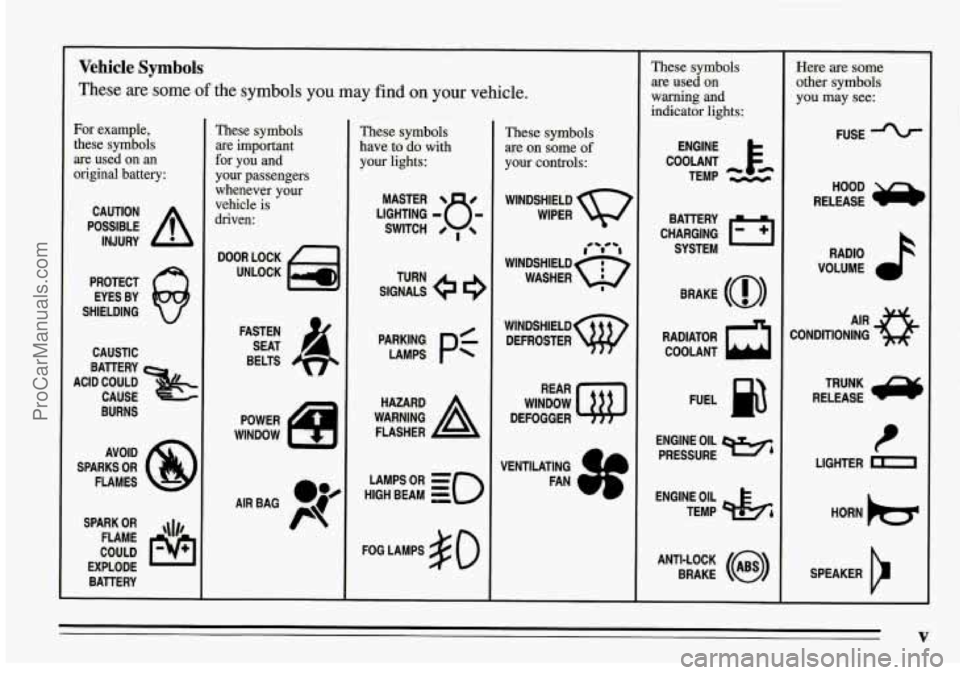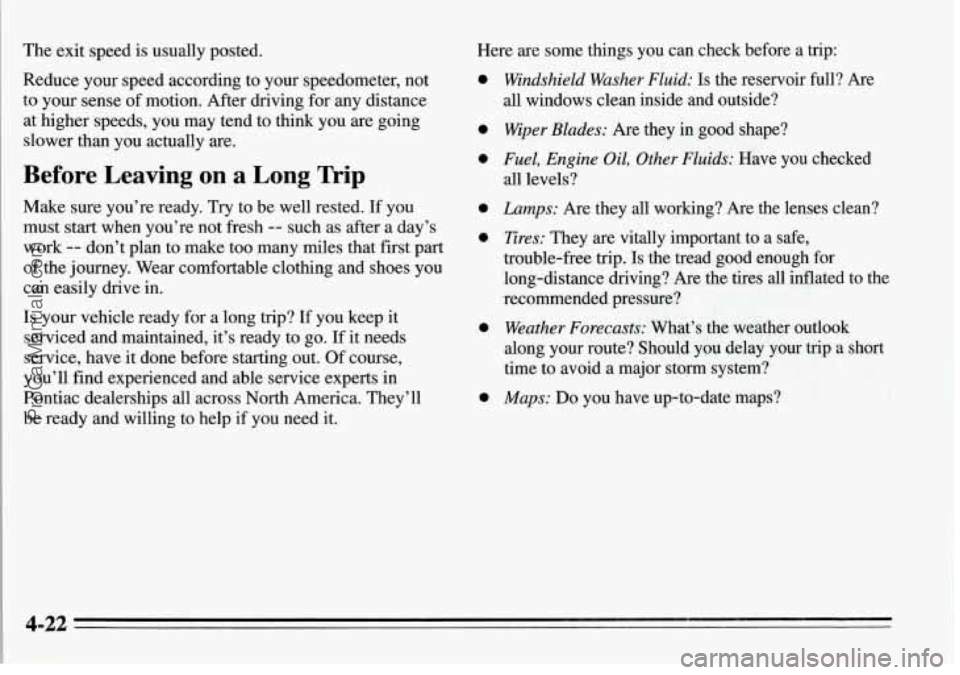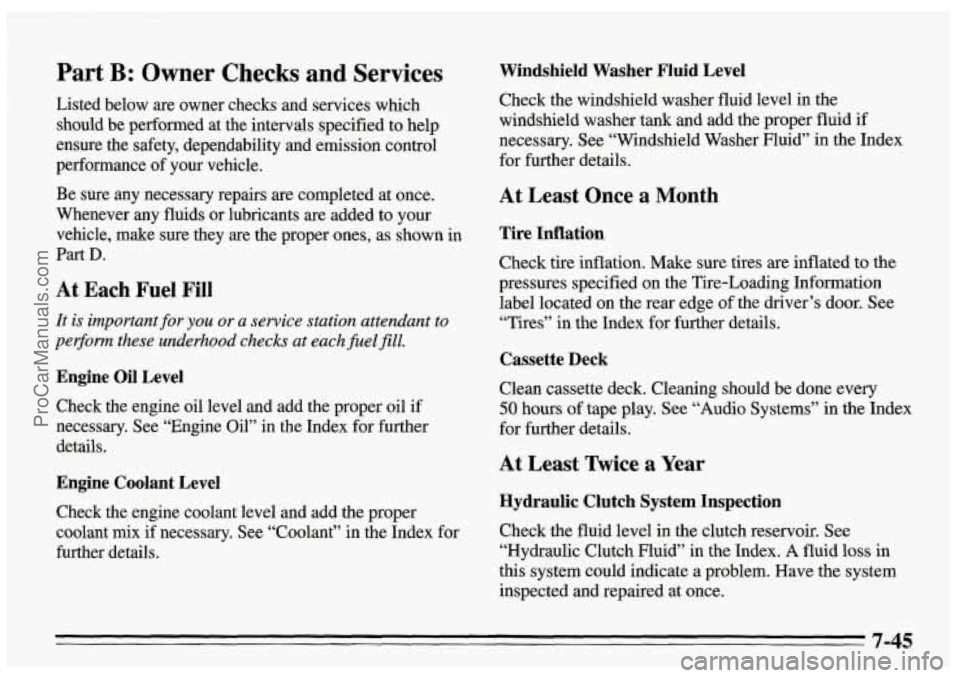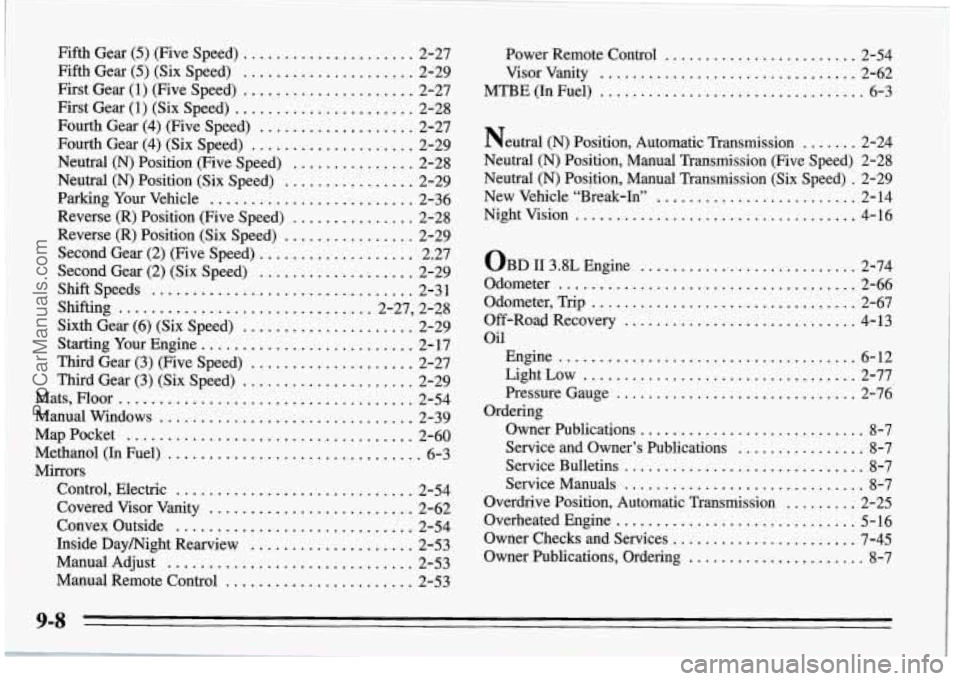fuel pressure PONTIAC FIREBIRD 1995 Owners Manual
[x] Cancel search | Manufacturer: PONTIAC, Model Year: 1995, Model line: FIREBIRD, Model: PONTIAC FIREBIRD 1995Pages: 386, PDF Size: 19.66 MB
Page 6 of 386

Vehicle Symbols
These are some of the symbols you may find on your vehicle.
For example, these symbols
are used on an
original battery:
POSSIBLE A
CAUTION
INJURY
PROTECT EYES BY
SHIELDING
CAUSTIC
BURNS
AVOID
SPARKS
OR
FLAMES
SPARK OR ,\I/,
COULD FLAME
EXPLODE BAllERY
These symbols
are important
for you and
your passengers
whenever your
vehicle is
driven:
FASTEN SEAT 4
BELTS
POWER
WINDOW
These symbols
have to
do with
your lights:
SIGNALS e
TURN
pAE: pf
HIGH LAMPSoR BEAM = =o
FOG LAMPS $0
These symbols are on some
of
your controls:
WINDSHIELD
WIPER
i ‘t’ i
WINDSHIELD Q
WASHER I
WINDSHIELD
DEFROSTER
WINDOW
DEFOGGER
VENTILATING FAN
These symbols
are used on
warning and
indicator lights:
COOLANT F*
TEMP --
ENGINE
CHARGING 1-1
BATTERY
SYSTEM
BRAKE (0)
RADIATOR COOLANT
a
FUEL
ENGINE OIL
PRESSURE
9%
TEMP OIL &
ANTI-LOCK (a)
BRAKE
-
Here are some
other symbols
you may see:
FUSE
RAM0 h
VOLUME
CONDITIONING AIR 43
RELEASE a
LIGHTER m
SPEAKER
b
V
ProCarManuals.com
Page 173 of 386

The exit speed is usually posted.
Reduce your speed according to your speedometer, not
to your sense of motion. After driving for any distance
at higher speeds, you may tend to
think you are going
slower than you actually are.
Before Leaving on a Long Trip
Make sure you’re ready. Try to be well rested. If you
must
start when you’re not fresh -- such as after a day’s
work
-- don’t plan to make too many miles that First part
of the journey. Wear comfortable clothing and shoes you
can easily drive in.
Is your vehicle ready for a long trip? If you keep it
serviced and maintained, it’s ready to go.
If it needs
service, have it done before starting out. Of course,
you’ll find experienced and able service experts in
Pontiac dealerships all across North America. They’ll
be ready and willing to help if you need it.
Here are some things you can check before a trip:
a
e
a
a
a
e
e
Windshield Washer Fluid: Is the reservoir full? Are
all windows clean inside and outside?
Wiper Blades: Are they in good shape?
Fuel, Engine Oil, Other Fluids: Have you checked
all levels?
Lamps: Are they all working? Are the lenses clean?
Tires: They are vitally important to a safe,
trouble-free trip. Is the tread good enough for
long-distance driving? Are the tires all inflated to the
recommended pressure?
Weather Forecasts: What’s the weather outlook
along your route? Should you delay your trip a short
time to avoid a major storm system?
Maps: Do you have up-to-date maps?
4-22
ProCarManuals.com
Page 180 of 386

Run your engine only as long as you must. This saves
fuel. When you run the engine, make it go a little faster
than just idle. That is, push the accelerator slightly. This
uses less fuel for the heat that you get and it keeps the
battery charged. You will need a well-charged battery to
restart the vehicle, and possibly for signaling later on
with your headlamps. Let the heater run for awhile.
Then, shut the engine off and close the window almost
all the way to preserve the heat. Start the engine again
and repeat this only when you feel really uncomfortable
from the cold. But do it as little as possible. Preserve the
fuel as long as you can.
To help keep warm, you can get
out of the vehicle and do some fairly vigorous exercises
every half hour or
so until help comes.
Loading Your Vehicle
TIRE-LOADING INFORMATION
VEHICLE CAP. WT.
FRT. CTR. RR. TOTAL LBS.
MAX. LOADING & GVWR SAME AS VEHICLE
CAPACITY WEIGHT XXX COLD TIRE
TIRE SIZE SPEED PRESSURE
RTG PSI/KPa
FRT.
RR.
SPA.
IF TIRES ARE HOT, ADD 4PS1/28KPa
SEE OWNER’S MANUAL FOR ADDITIONAL
\INFORMATION
Two labels on your vehicle show how much ‘weight it ’
may properly carry. The Tire-Loading Information label
found on the driver’s door tells you the proper size,
speed rating and recommended inflation pressures for
the tires
on your vehicle. It also gives you important
information about the number of people that can be in
your vehicle and the total weight that you can carry.
This weight is called the Vehicle Capacity Weight and
includes the weight of all occupants, cargo, and all
nonfactory-installed options.
4-29
ProCarManuals.com
Page 282 of 386

Inflation - Tire Pressure
The Tire-Loading Information label which is on the
driver’s door shows the correct inflation pressures for
your tires, when they’re cold. “Cold” means your
vehicle has been sitting for at least three hours or driven no more than a mile.
If you’ll be driving at speeds higher than 100 mph (160 km/h)
where it is legal, raise the “cold” inflation pressure of\
each
tire to 35 psi (240 k Pa). When you end this very high speed
driving, reduce the “cold” inflation pressures to those
listed
on the tire loading information label.
Don’t let anyone tell you that underinnation or
overinflation
is all right. It’s not. If’ your tires don’t
have enough
air (underinflation) you can get:
Too much flexing
Too much heat
Tire overloading
Bad wear
0 Bad handling
Bad fuel economy.
(Continued)
NOTICE: (Continued)
If your tires have too much air (overinflation),
you can get:
Unusual wear
Bad handling
Rough ride
0 Needless damage from road hazards.
. ., .. ,
When to Check
Check your tires once a month or more.
Don’t forget your compact spare tire. It should be at
60 psi (420 kPa).
How to Check
Use a good quality pocket-type gage to check tire
pressure. Simply looking at the tires will not tell you the
pressure, especially if you have radial tires
-- which
may look properly inflated even
if they’re underinflated.
If your tires have valve caps, be sure to put them back
on. They help prevent leaks by keeping ou,t dirt and
moisture.
6149
ProCarManuals.com
Page 335 of 386

Maintenance Schedule I
90,000 Miles (150 000 km) (Continued)
Inspect spark plug wires. An Emission Control
Service. f
- Uses such as found in taxi, police or
delivery service. ~
If you
do not use your vehicle under any of
these conditions, change the fluid and filter
at
100,000 miles (166 000 km).
Manual transmission fluid doesn’t require
change.
every 24 months, whichever occurs first).
0 Drain, flush and refill cooling system (or
every
24 months, whichever occurs first).
See “Engine Coolant’’ in the Index for what
to use. Inspect hoses. Clean radiator,
condenser, pressure cap and neck. Pressure
test the cooling system and pressure cap.
I7 Replace spark plugs (except 5.7L Code P
0 Inspect engine accessory drive belt (or
An Emission Control Service.
An Emission Control Service.
engine). An Emission Control Service.
7-28
0 Replace air cleaner filter. Replace filter
more often under dusty conditions.
An Emission Control Service.
0 Inspect fuel tank, cap and lines for damage
or leaks. Inspect fuel cap gasket for any
damage. Replace parts as needed.
An,Emission Control Service. f
0 Rotate tires. See “Tire Inspection and
Rotation” in the Index for proper rotation
pattern and additional information.
ProCarManuals.com
Page 342 of 386

Maintenance Schedule I1 r
- Uses such as found in taxi, police or
delivery service.
If you do not use your vehicle under any of
these conditions, change the fluid and filter
at 100,000 miles (1 66 000 km).
Manual transmission fluid doesn’t require
change.
every
24 months, whichever occurs first).
An Emission Control Service.
Cl Drain, flush and refill cooling system (or
every
24 months, whichever occurs first).
See “Engine Coolant” in the Index for what
to use. Inspect hoses. Clean radiator,
condenser, pressure cap and neck. Pressure
test the cooling system and pressure cap.
Inspect engine accessory drive belt (or
An Emission Control Service.
6.: :
13 Replace spark plugs (except 5.7L Code P
Inspect spark plug wires. An Emission Control
Replace air cleaner filter. An Emission Control
0 Inspect fuel tank, cap and lines for damage I
engine). An Emission Control Service.
Service.
Service.
or leaks. Inspect fuel cap gasket for any
damage. Replace parts as needed.
An Emission Control Service.
7-35
ProCarManuals.com
Page 350 of 386

Maintenance Schedule I1
- In hilly or mountainous terrain.
- When doing frequent trailer towing.
- Uses such as found in taxi, police or
delivery service.
Ifyou do not use your vehicle under any of
these conditions, change the fluid and filter
at 100,000
miles (1 66 000 km).
Manual transmission fluid doesn’t require
change.
0 Drain, flush and refill cooling system (or
every
24 months, whichever occurs first).
See “Engine Coolant” in the Index for what
to use. Inspect hoses. Clean radiator,
condenser, pressure cap and neck. Pressure
test the cooling system and pressure cap.
An Emission Control Service.
Replace spark plugs (except 5.7L Code P
c] Inspect spark plug wires. An Emission Control
Replace air cleaner filter. An Emission Control
0 Inspect fuel tank, cap and lines. Inspect fuel
cap gasket for any damage. Replace parts as
needed.
An Emission Control Service. T
engine). An Emission Control Service.
Service.
T
Sewice.
DATE SERVICED BY: ACTUAL MILEAGE
7-43
ProCarManuals.com
Page 352 of 386

Part B: Owner Checks and Services
Listed below are owner checks and services which should be performed at the intervals specified to help
ensure the safety, dependability and emission control
performance
of your vehicle.
Be sure any necessary repairs are completed at once.
Whenever any fluids or lubricants are added to your
vehicle, make sure they are the proper ones, as shown
in
Part D.
At Each Fuel Fill
It is important for you or a service station attendant to
peqorm these underhood checks at each fuel
fill.
Engine Oil Level
Check the engine oil level and add the proper oil if
necessary. See “Engine Oil” in the Index for further
details.
Engine Coolant Level
Check the engine coolant level and add the proper
coolant mix
if necessary. See “Coolant” in the Index for
further details.
Windshield Washer Fluid Level
Check the windshield washer fluid level in the
windshield washer tank and add the proper fluid
if
necessary. See “Windshield Washer Fluid” in the Index
for further details.
At Least Once a Month
Tire Inflation
Check tire inflation. Make sure tires are inflated to the
pressures specified on the Tire-Loading Information
label located on the rear edge of the driver’s door. See
“Tires” in the Index for further details.
Cassette Deck ; ,.
Clean cassette deck. Cleaning should be done every
50 hours of tape play. See “Audio Systems” in the Index
for further details.
At Least Mce a Year
Hydraulic Clutch System Inspection
Check the fluid level in the clutch reservoir. See
“Hydraulic Clutch Fluid” in the Index. A fluid loss in
this system could indicate a problem. Have the system
inspected and repaired at once.
7-45
ProCarManuals.com
Page 379 of 386

Power Remote Control ........................ 2-54
Visor Vanity
................................ 2-62
MTBE (In Fuel) ................................. 6-3
Neutral (N) Position. Automatic Transmission ....... 2-24
Neutral (N) Position. Manual Transmission (Five Speed) 2-28
Neutral
(N) Position. Manual Transmission (Six Speed) . 2-29
New Vehicle “Break-In” ......................... 2-14
Nightvision
................................... 4-16
OBD IT 3.8L Engine ........................... 2-74
Odometer, Trip
................................. 2-67
Off -Road Recovery ............................. 4-13
Engine
..................................... 6-12
Pressure Gauge
.............................. 2-76
OwnerPublications ............................ 8-7
Service and Owner’s Publications
................ 8-7
Service Bulletins
.............................. 8-7
Overdrive Position, Automatic Transmission ......... 2-25
Overheated Engine
.............................. 5-16
Owner Checks and Services
....................... 7-45
Owner Publications, Ordering
...................... 8-7
Odometer ..................................... 2-66
Oil
LightLow .................................. 2-77
Ordering
ServiceManuals .............................. 8-7
9-8
ProCarManuals.com